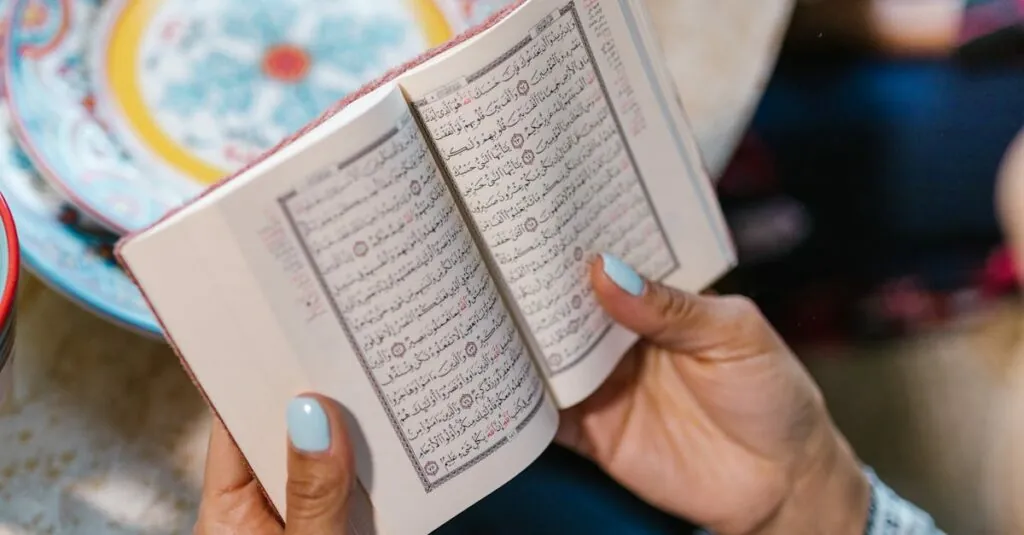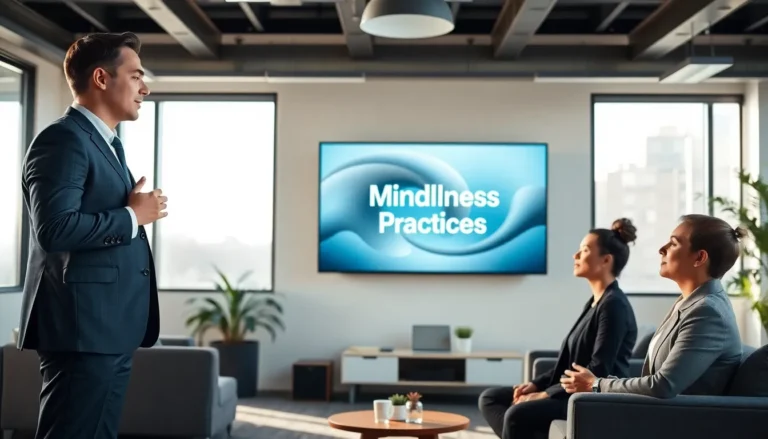Table of Contents
ToggleIn a world buzzing with distractions and endless to-do lists, finding peace can feel like searching for a needle in a haystack. But what if the secret to calmness and clarity lies in a few simple yet powerful mindfulness practices? High-impact mindfulness isn’t just about sitting cross-legged and chanting “om.” It’s about embracing techniques that can transform daily chaos into moments of serenity, all while keeping a smile on your face.
Imagine tackling stress with the same enthusiasm you’d reserve for your favorite snack. These practices not only boost mental clarity but also sprinkle a little joy into the mundane. Whether you’re a seasoned meditator or a curious newbie, there’s something here for everyone. So buckle up and get ready to explore how high-impact mindfulness can turn your hectic life into a more balanced and fulfilling experience.
Overview of High-Impact Mindfulness Practices
High-impact mindfulness practices focus on integrating mindfulness into daily life, making it accessible and practical. These approaches often involve simple techniques that can easily fit into anyone’s routine. Each technique aims to reduce stress and increase overall well-being.
Breath awareness stands out as one effective practice. This method can be done anywhere and provides immediate calming effects. By concentrating on each inhale and exhale, individuals reconnect with the present moment.
Body scans offer another valuable practice. This technique involves systematically directing attention to various parts of the body. Relaxation follows as individuals become aware of tension and consciously release it.
Mindful walking serves as an engaging alternative. Participants focus on their steps and surroundings, creating an opportunity for movement-based mindfulness. Engaging with the outdoor environment enhances the connection to nature and self.
Gratitude journaling also plays a crucial role in high-impact mindfulness. Writing down positive experiences or things one is thankful for boosts mood and cultivates a positive mindset. These reflections encourage a shift in perspective, helping to counter negative thoughts.
By prioritizing these practices, individuals can find moments of peace amid daily challenges. The essence of high-impact mindfulness lies in its ability to transform ordinary moments into opportunities for mindfulness. Exploring these techniques can lead to significant improvements in mental clarity and emotional balance.
Benefits of High-Impact Mindfulness Practices
High-impact mindfulness practices offer multiple benefits across different aspects of life. These practices enhance physical and mental well-being, making them essential for anyone seeking balance in a chaotic world.
Physical Health Benefits
High-impact mindfulness practices significantly contribute to improved physical health. Regular engagement in techniques like breath awareness can lower blood pressure and reduce heart rates. Body scans promote relaxation, which aids in muscle tension relief. Mindful walking encourages physical activity, leading to enhanced cardiovascular health. These practices also bolster immune function, enhancing body’s ability to fend off illness. Research shows that individuals incorporating mindfulness into their routines experience fewer chronic pain episodes.
Mental Health Benefits
High-impact mindfulness practices provide substantial mental health benefits. Individuals practicing gratitude journaling report increased feelings of happiness and reduced symptoms of anxiety and depression. Breath awareness serves as an effective tool for alleviating stress, leading to heightened emotional resilience. Engaging in mindful walking fosters greater present-moment awareness, which diminishes rumination and fosters positive thinking patterns. Studies indicate that frequent mindfulness practice correlates with improved focus and cognitive flexibility, ultimately enhancing overall mental clarity and emotional balance.
Popular High-Impact Mindfulness Practices
High-impact mindfulness practices offer practical ways to cultivate presence and reduce stress. Here are some popular techniques that can enhance well-being.
Mindfulness Meditation
Mindfulness meditation centers on attention and awareness. This practice encourages individuals to focus on the present moment, which cultivates relaxation. Participants often sit in a comfortable position and concentrate on their breath or a specific thought. Studies show that regular mindfulness meditation reduces anxiety and promotes emotional stability. Engaging in just a few minutes daily can lead to lasting benefits in mental clarity and overall mood.
Body Scan Technique
The body scan technique promotes relaxation through awareness of bodily sensations. It involves mentally scanning the body from head to toe. Practitioners typically notice tension or discomfort without judgment. This awareness encourages individuals to release stress held in different areas. Research indicates that body scans significantly lower stress levels, helping individuals connect with their physical selves. Scheduling a few minutes each day for this practice fosters a deeper sense of calm and tranquility.
Gratitude Journaling
Gratitude journaling focuses on recognizing and appreciating positive aspects of life. Individuals write down things they are grateful for, creating a habit of reflection. This technique fosters a positive mindset and improves overall happiness. Statistics show that keeping a gratitude journal can decrease symptoms of depression and anxiety. Setting aside time each day to journal can lead to a profound shift in perspective, reminding individuals of the abundance in their lives.
Implementing High-Impact Mindfulness Practices
Practicing mindfulness in daily life requires intention and structure. Establishing simple routines helps integrate mindfulness without overwhelming individuals.
Creating a Daily Routine
Starting a daily routine involves dedicating specific times for mindfulness activities. Individuals can begin with five minutes of breath awareness each morning. Adopting techniques like mindful walking during lunch breaks also enhances awareness and engagement with the surroundings. Scheduling moments for gratitude journaling before bed allows reflection on positive experiences throughout the day. Choosing consistent times promotes habit formation, making mindfulness a natural part of life. Engaging in daily practices consistently leads to more significant mental clarity and emotional resilience.
Setting Realistic Goals
Setting realistic goals facilitates a gradual integration of mindfulness into daily life. Individuals might aim for short mindfulness sessions over longer, daunting commitments. For example, starting with three mindfulness exercises per week can be manageable. People can increase frequency as they become more comfortable. Tracking progress helps maintain motivation and accountability. Each small milestone accomplished reinforces the importance of mindfulness, ultimately fostering lasting habits that contribute to enhanced overall well-being.
Challenges and Solutions
High-impact mindfulness practices present unique challenges. However, effective solutions exist to help individuals navigate these obstacles.
Overcoming Common Barriers
Many people face distractions that hinder effective mindfulness. Time constraints often prevent individuals from engaging in these practices. Prioritizing short techniques, such as breath awareness, can make mindfulness more manageable. Additionally, creating a dedicated mindfulness space reduces environmental distractions. Addressing feelings of self-judgment is crucial, as these thoughts can undermine progress. Practicing self-compassion boosts confidence, making it easier to engage in mindfulness without fear of failure.
Maintaining Consistency
Establishing a routine is vital for consistent mindfulness practice. Scheduling specific times each day helps individuals integrate techniques into their lives. For example, dedicating five minutes in the morning for breath awareness promotes regularity. Tracking progress using a journal reinforces commitment and motivation. Setting achievable goals, like starting with two sessions per week, eases individuals into a steady practice. Emphasizing the importance of patience makes the journey feel less daunting, cultivating lasting habits over time.
Embracing high-impact mindfulness practices can profoundly transform daily life. By incorporating simple techniques like breath awareness and gratitude journaling, individuals can create pockets of calm amidst chaos. These practices not only enhance mental clarity but also foster emotional resilience and physical health.
As readers explore these approaches, they’ll find that even small, intentional changes can lead to significant improvements in their overall well-being. Prioritizing mindfulness isn’t just about finding peace; it’s about cultivating a richer, more fulfilling life. With patience and consistency, anyone can develop a mindfulness routine that suits their lifestyle and enhances their daily experiences.




